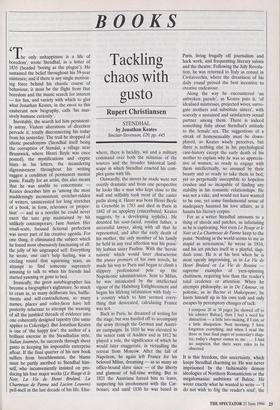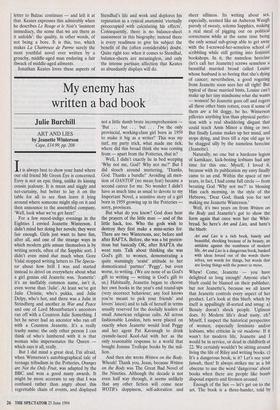BOOKS
Tackling chaos with gusto
Rupert Christiansen
STENDHAL by Jonathan Keates Sinclair-Stevenson, £20, pp. 445 The only unhappiness is a life of boredom', wrote Stendhal, in a letter of 1835 (headed 'boring as the plague'). He sustained the belief throughout his 59-year existence; and if there is any single motivat- ing force behind his chaotic course of behaviour, it must be the flight from that boredom and the manic search for interest — for fun, and variety with which to glut what Jonathan Keates, in the envoi to this exuberant new biography, calls 'his mas- sively humane curiosity'.
Inevitably, the search led him persistent- ly astray. Violent alterations of direction pervade it, totally disconnecting his today from his yesterday. The trail he dropped of idiotic pseudonyms (Stendhal itself being the corruption of Stendal, a village near Brunswick, where Henri Beyle was once posted), the mystifications and cryptic hints in his letters, the meandering digressiveness throughout his writing suggest a condition of permanent mental panic. Fatally for an artist, this also meant that he was unable to concentrate Keates describes him as 'among the most maddeningly inconsistent, crotchet-ridden of writers, uninterested for long stretches of a book, in form, relevance or propor- tion' — and as a novelist he could never exert the sure grip maintained by his unlikely contemporary, Jane Austen. Her small-scale, focused fictional perfection was never part of his creative agenda. For one thing, it eliminated the subject which he found most obsessively fascinating of all: the jelly of his ungrasped self. Everything he wrote, one can't help feeling, was a circling round that squirming mass, an attempt to find someone supremely amusing to talk to when his friends had started yawning or gone to bed. Ironically, the great autobiographer has become a biographer's nightmare. So much to cram in, so many deliberate lies, baffle- ments and self-contradictions, so many names, places and voltes-faces have left posterity reluctant to attempt the weaving of all the jumbled threads of evidence into one coherently designed tapestry (the same applies to Coleridge). But Jonathan Keates is one of 'the happy few'; the author of a brilliant exercise in the Stendhalian style, Italian Journeys, he succeeds through sheer gusto in keeping his impossible enterprise afloat. If the final quarter of his new book suffers from breathlessness, the blame must be partly ascribed to Stendhal him- self, who inconveniently insisted on pro- ducing his four major works (Le Rouge et le Noir, La Vie de Henri Brulard, La Chartreuse de Parme and Lucien Leuwen) pell-mell in the last decade of his life. Else- where, there is lucidity, wit and a military command over both the minutiae of the sources and the broader historical land- scape in which Stendhal enacted his com- plex game with life.
Outwardly, the moves he made were not overtly dramatic and from one perspective he looks like a man who kept close to the wall and selfishly took most of the easier paths along it. Henri was born Henri Beyle in Grenoble in 1783 and died in Paris in 1842 of an apoplexy (exacerbated, Keates suggests, by a developing syphilis). He detested his sour-faced, royalist father, a successful lawyer, along with all that he represented, and after the early death of his mother, the only member of his family he held in any real affection was his possi- bly lesbian sister Pauline. With the 'heroic naivete' which would later characterise the jeunes premiers of his own novels, he made his way to Paris and began to climb a slippery professional pole up the Napoleonic administration. Sent to Milan, he was intoxicated by the intellectual vigour of the Habsburg Enlightenment and began his lifelong infatuation with Italy a country which to him seemed every- thing that desiccated, calculating France was not.
Back in Paris, he dreamed of writing for the stage, but was hustled off to accompany the army through the German and Austri- an campaigns. In 1810 he was elevated to the senior rank of Auditor and in 1812 he played a role, the significance of which he would later exaggerate, in victualling the retreat from Moscow. After the fall of Napoleon, he again left France for his beloved Milan, dreaming — as so many an office-bound slave since — of the liberty and glamour of full-time writing. But in 1821 the Austrians forced him to leave, suspecting his involvement with the Car- bonari, and until 1830 he was based in Paris, living frugally off journalism and hack work, and frequenting literary salons and the theatre. Following the July Revolu- tion, he was returned to Italy as consul in Civitavecchia, where the dreariness of his daily round proved the best incentive to creative endeavour.
Along the way he encountered 'an unbroken parade', as Keates puts it, 'of idealised mistresses, projected wives, surro- gate mothers and substitute sisters', with scarcely a sustained and satisfactory sexual partner among them. There is indeed something fishy about Stendhal's attitude to the female sex. The suggestions of a streak of homosexuality must be down- played, as Keates wisely perceives, but there is nothing else in his psychological case-history except the early death of his mother to explain why he was so apprecia- tive of women, so ready to engage with them intellectually, so aroused by their beauty and so ready to take them to bed, yet so perpetually susceptible to hopeless crushes and so incapable of finding any stability in his romantic relationships. He was not a rake, and would not have wanted to be one, yet some fundamental sense of inadequacy haunted his love affairs, as it haunts his literary corpus.
For as a writer Stendhal amounts to a thing of shreds and patches, as infuriating as he is captivating. Not even Le Rouge et le Noir or La Chartreuse de Parme keep to the point. 'Nothing in the world seems to me as stupid as seriousness,' he wrote in 1834, and his art pitches itself in a playful, slap- dash zone. He is at his best when he is most openly improvising, as in La Vie de Henri Brulard or La Vie de Rossini supreme examples of yarn-spinning chattiness, requiring less than the reader's total credence or attention. When he attempts philosophy, as in De ?Amour, or polemic, as in Racine et Shakespeare, he knots himself up in his own tosh and only escapes by peremptory changes of tack: I compose 20 or 30 pages [he showed off to his admirer Balzac], then I feel a need for distraction — a little love-making, if I can, or a little dissipation. Next morning, I have forgotten everything, and when I read the three or four final pages of yesterday's chap- ter, today's chapter comes to me .. . I had no suspicion that there were rules to be observed.
It is this freedom, this uncertainty, which keeps Stendhal charming us. He was never imprisoned by the fashionable demon ideologies of Northern Romanticism or the megalomaniac ambitions of Balzac. He wrote exactly what he wanted to write — 'I do not wish to frig the reader's soul', the letter to Balzac continues — and left it at that. Keates expresses this admirably when he describes Le Rouge et le Noir's 'insistent immediacy, the sense that we are there as it unfolds': the quality, in other words, of not being a bore. It is this, too, which makes La Chartreuse de Parme surely the most youthful novel ever written by a grouchy, middle-aged man enduring a fair thwack of middle-aged ailments.
Jonathan Keates loves these aspects of Stendhal's life and work and deplores his reputation as a cynical anatomist 'eternally preoccupied with calculating his effects'. Consequently, there is no balance-sheet assessment in this biography; instead there is every readiness to give his subject the benefit of the (often considerable) doubt. Quite right too: when it comes to Stendhal, balance-sheets are meaningless, and only the intense partisan affection that Keates so abundantly displays will do.

































































 Previous page
Previous page